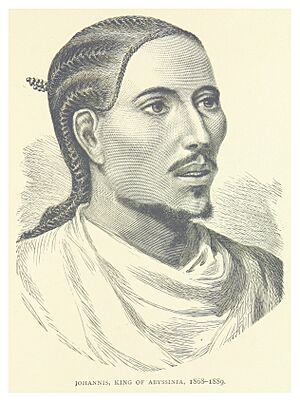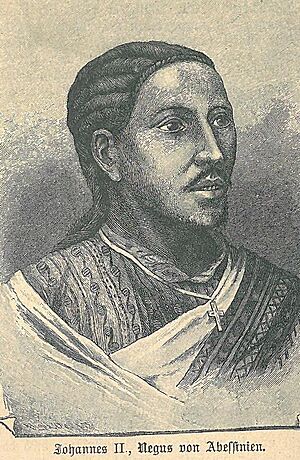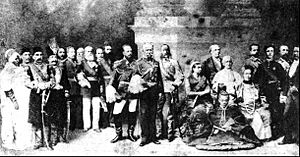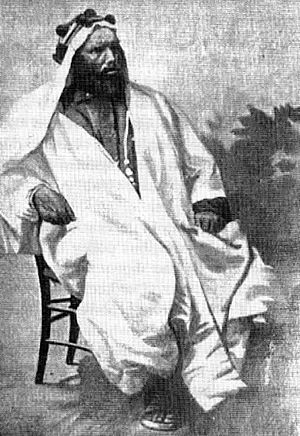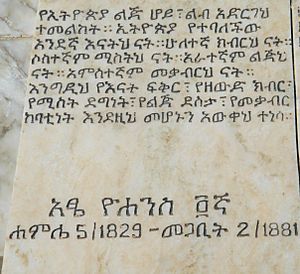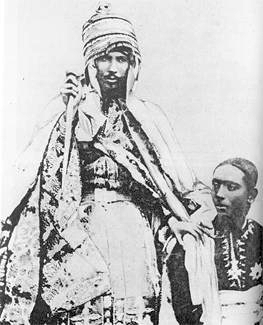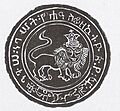Yohannes IV facts for kids
Quick facts for kids Yohannes IVዮሓንስ ፬ይ |
|
|---|---|
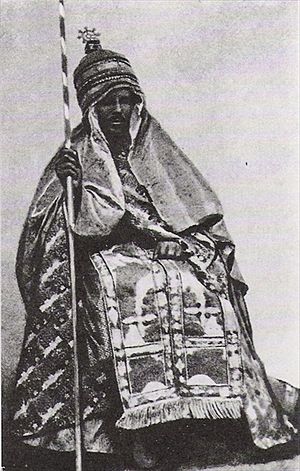
Yohannes IV
|
|
| Emperor of Ethiopia | |
| Reign | 11 July 1871 – 10 March 1889 |
| Coronation | 12 January 1872 |
| Predecessor | Tekle Giyorgis II |
| Successor | Menelik II |
| Born | 11 July 1837 May Baha, Tembien, Ethiopian Empire |
| Died | 10 March 1889 (aged 51) Gallabat, Mahdist State |
| Spouse | Woizero Tibebe Selassie |
| Issue | Ras Araya Selassie Ras Mengesha |
| Dynasty | House of Solomon (Tigrayan Branch) |
| Father | Dejazmatch Mercha Wolde Kidan, Shum of Tembien |
| Mother | Woizero Silass Dimtsu of Chelekot, Enderta |
| Religion | Ethiopian Orthodox Tewahedo Church |
Yohannes IV (born Lij Kassa Mercha; 11 July 1837 – 10 March 1889) was the Emperor of Ethiopia from 1871 until his death in 1889. He was also the King of Tigray before becoming Emperor. Yohannes IV worked to unite Ethiopia, a goal started by an earlier emperor, Tewodros II. He also traveled across regions to meet with local leaders.
Yohannes helped the British during their expedition to Ethiopia, which led to Tewodros II's death. For his help, Yohannes received weapons and artillery. He faced many challenges, including conflicts with Egypt and the Mahdist State in Sudan.
Contents
Early Life and Rise to Power
Yohannes IV came from important families in the regions of Tembien, Agame, and Enderta. His father, Mercha Wolde Kidan, was a ruler in Tembien. His mother, Silas Dimtsu, was also from a powerful family. He was related to the Solomonic Dynasty through his grandmother.
Not much is known about his early life. He was the youngest of his siblings and had some church education. He first appeared in politics around 1864, visiting Emperor Tewodros II. He was given a small title and assigned to a sub-district under his older brother.
Soon after returning to Tigray, Kassa (Yohannes's birth name) rebelled against Emperor Tewodros II. It's believed he was unhappy with his low rank or was responding to a call from a religious leader who criticized Tewodros. Kassa found safety among the Afar people and married a Muslim woman who later became Christian.
| Styles of Yohannes IV of Ethiopia |
|
|---|---|
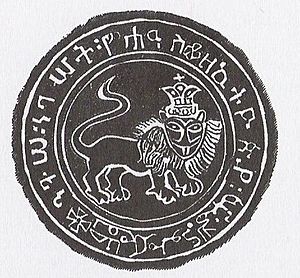 |
|
| Reference style | Tigrinya: ግርማዊ girmāwī His Imperial Majesty |
| Spoken style | Amharic: ጃንሆይ djānhoi Your Imperial Majesty (lit. "O [esteemed] royal") |
| Alternative style | Amharic: ጌтоቹ getochu Our Lord (familiar) (lit. "Our master" (pl.)) yohanes |
He then built up his army and defeated several local leaders between 1864 and 1867. He even defeated Tekle Giyorgis, who had killed Kassa's mother. After this victory, Kassa took the title of däjazmač. He then allied with another powerful leader, Gobez Gebre Medhin, against Tewodros. Kassa continued to win battles, gaining more control over different regions.
Becoming Emperor
Yohannes's goal to become Emperor grew stronger as Tewodros II's rule weakened. In 1867, he began to present himself as the ruler of Ethiopia to the British. At this time, a conflict between Tewodros and the British led to a British expedition to free European prisoners.
In February 1868, Yohannes met with British officers, including their commander, Sir Robert Napier. Yohannes agreed to help Napier, making it easier for the British troops to get supplies. He promised to protect their supply routes and telegraph lines. In return, Yohannes asked for British help against his rival, Wagshoum Gobeze (Tekle Giyorgis II). Napier refused direct military help but offered assistance after the campaign.
On April 10, 1868, the British forces reached Magdala. Three days later, Emperor Tewodros II died by suicide after refusing to surrender. Yohannes's help was crucial for the British victory. British officers admitted they were "lucky" to have his cooperation.
As a reward, Yohannes received a large amount of military equipment, including mortars, howitzers, muskets, rifles, and ammunition. This greatly increased his army's strength. A British instructor, John C. Kirkham, also stayed to train Yohannes's troops to use these modern weapons. This combination of new weapons and training was key to his future battles.
After Tewodros's death, Gobeze Gebre Medhin crowned himself Emperor Tekle Giyorgis II. However, Yohannes refused to recognize him. Although Tekle Giyorgis had a larger army, he lacked modern weapons like Yohannes. He also worried that his soldiers from Tigray might switch sides to Yohannes. Tekle Giyorgis tried to get help from Menelik, the King of Shewa, but Menelik chose to wait and see who would win.
Finally, on July 11, 1871, Tekle Giyorgis fought Kassa at the Battle of Adwa. Kassa won, and Tekle Giyorgis was defeated and imprisoned. Two years later, he died. With this victory, Kassa became the undisputed ruler of Ethiopia and was crowned Emperor Yohannes IV.
Ruling Ethiopia
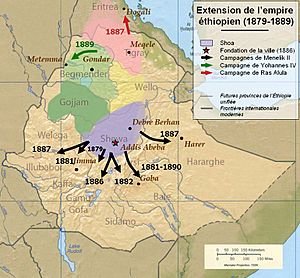
Emperor Yohannes IV wanted to continue uniting Ethiopia, just like Tewodros II. He traveled to different regions, meeting with local governors. He made sure these leaders were loyal to him, no matter their past actions. He was known for being fair and keeping peace. People said that during his reign, "a child could pass through his dominions unharmed."
In his first six years, he successfully united most Christian provinces. He crowned Menelik as King of Shewa in 1878 and Tekle Haymanot as King of Gojjam and Kaffa in 1881. He encouraged them to expand their kingdoms to the south, east, and west. However, this led to a rivalry between Menelik and Tekle Haymanot, which resulted in the Battle of Embabo in 1882. Yohannes scolded them for fighting without his permission. He punished them by taking away some land and set clear directions for where each king could expand.
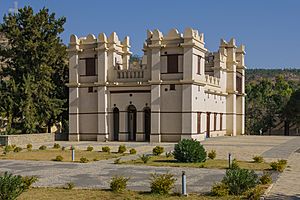
For the first ten years, Yohannes did not have a fixed capital city. He moved around, much like earlier Ethiopian emperors. He often stayed in Adwa, Amba Chara, and Semera. In the early 1880s, he chose Mekelle as his main center and had a palace built there by an Italian craftsman.
Religious Policies
Yohannes faced challenges with religious groups in Ethiopia: different views within the Ethiopian Orthodox Tewahedo Church, the presence of Islam, and foreign Christian missionaries. He saw these as threats to the unity of his empire.
In 1878, Yohannes called a major religious council at Boru Meda. Important leaders and theologians from different Christian groups debated their beliefs. Yohannes had a plan for the council. At the end, a letter from the Patriarch of Alexandria was read, supporting the Emperor's chosen religious teachings. This policy aimed to unify the church, though some differing beliefs continued quietly.
Foreign Challenges
War with Egypt
Throughout his reign, Yohannes had to defend Ethiopia's borders, especially in the north. The first major conflict was with Isma'il Pasha, the leader of Egypt, who wanted to control the entire Nile River basin. The Egyptians tried to encourage Menelik of Shewa against Yohannes, but they angered Menelik by taking the city of Harar in 1875. Both Menelik and Yohannes considered Harar part of Ethiopia.
The Egyptians then marched into northern Ethiopia from their coastal lands near Massawa. Yohannes asked the British to stop their Egyptian allies and even pulled back his troops to show he was not the aggressor. However, when he realized the Europeans would not intervene, he gathered his armies to meet the Egyptian forces.
The two armies clashed at Gundet on November 16, 1875. The Egyptians were tricked into a narrow valley and were wiped out by Ethiopian gunners hidden in the mountains. Most of the Egyptian force, including many European and North American officers, were killed. News of this huge defeat was kept secret in Egypt.
A new Egyptian army was sent to get revenge. But they were defeated again at the Battle of Gura (March 7–9, 1876). Emperor Yohannes and his skilled general, Alula Engida, led the Ethiopians to victory. After this, Menelik submitted to Yohannes in 1878. Yohannes recognized Menelik's right to be King of Shewa and crowned him again. To strengthen their bond, Yohannes arranged for Menelik's daughter, Zewditu, to marry his own son and heir, Ras Araya Selassie. By 1878, after winning the war against Egypt, Yohannes was at the peak of his power.
War with Sudan
Later, Muhammad Ahmad declared himself the Mahdi (a prophesied Islamic leader) and started a major revolt in Sudan. His followers, called Mahdists, drove out many Egyptian soldiers. Yohannes agreed to British requests to let these Egyptian soldiers leave Sudan through his lands. In return, he hoped the British would support his claim to important ports like Massawa on the Red Sea, which would allow him to import weapons. This agreement was written in the Hewett Treaty.
However, this treaty angered the Mahdists. In 1885, Ras Alula defeated an invading Mahdist army at the Battle of Kufit. Around the same time, Italy took control of Massawa, which disappointed Yohannes and made him angry.
Yohannes tried to make a deal with the Italians so he could focus on the Mahdists. However, Ras Alula attacked Italian units near the border. Internal problems also grew as the Kings of Gojjam and Shewa rebelled against Yohannes. The Emperor had to deal with these rebellions instead of the Italians. He quickly crushed the Gojjam rebellion. But before he could deal with Shewa, news arrived that the Mahdist forces had attacked Gondar, burning churches and looting the country. Yohannes then marched north from Gojjam to face the Mahdist armies.
Death of the Emperor
Emperor Yohannes IV was killed by Mahdist Sudanese forces at the Battle of Gallabat (also known as Metemma) on March 10, 1889. He was shot and mortally wounded while fighting bravely on the front lines. He was carried to his tent, where he declared that his nephew, Ras Mengesha, was actually his natural son and named him his heir. His older son, Ras Araya Selassie, had died a few years earlier. Yohannes died hours later.
Even though the Ethiopian army had almost won the battle, hearing that their Emperor was dead crushed their spirits. The army scattered, and the Sudanese, who were almost defeated, then took control.
Yohannes's body was being carried back to Tigray by a small group when Mahdist troops captured it near the Atbara River. The Mahdists took the Emperor's body to their capital, Omdurman, where his head was put on a pole and paraded through the streets.
After Yohannes's death, on May 2, 1889, Emperor Menelik II signed the Treaty of Wuchale with the Italians. This treaty later led to the famous Battle of Adwa.
Descendants and Legacy
After Yohannes's death, some Tigrean nobles tried to make Ras Mengesha Yohannes (who Yohannes had named his son and heir) the new Emperor. However, many of Yohannes's other relatives disagreed and rebelled against Mengesha. They did not believe Mengesha was Yohannes's son, having known him as his nephew. Tigray became divided by these conflicts.
Menelik II of Shewa took advantage of this disorder. After the Italians took over Hamasien, Menelik was proclaimed Emperor of Ethiopia. Yohannes's death reduced the power of Tigrayan nobles in the Ethiopian government. It also allowed the Italians to take more land, which eventually led to the creation of the colony of Eritrea.
Yohannes IV had his weaknesses, but he was largely shaped by the challenges of his time. During his 18-year reign, he focused on defending Ethiopia from attacks by Egyptians, Italians, and Mahdists. He worked hard to bring peace and expand the empire by sharing power and being flexible. His main goals were peace and the good of his country, not just his own power.
His decision to share authority with Menelik and Tekle Haymanot eventually weakened his own power, but it greatly helped to reunite the Ethiopian Empire. By keeping local leaders in place, he reduced the fear and uncertainty that had been common in earlier reigns. His kindness and forgiveness towards his defeated enemies earned him great respect from his people.
For example, after defeating Gabre Mikael, who was responsible for his mother's death, Yohannes not only forgave him but also reinstated him as a councilor. Later, Gabre Mikael's son also held important positions. Similarly, when Ras Adal of Gojjam killed his cousin, Yohannes forgave him and made him King of Gojjam and Keffa, under the name Tekle Haymanot.
Menelik's ambition to become Emperor was clear even before Yohannes's reign. Menelik only fully submitted to Yohannes in 1878, after Yohannes gained a huge advantage in weapons from his victories over the Egyptian army. Even when his advisors urged him to remove Menelik, Yohannes refused. He believed it was wrong to destroy a strong leader like Menelik just to remove a possible threat to himself.
Later, Yohannes learned that both Menelik and Tekle Haymanot had secretly agreed to rebel against him. At this point, it would have been easy for Yohannes to attack Menelik's territory. However, Yohannes's priority was to face the external threat from the Mahdists, who had twice attacked Gondar, burning churches and enslaving people. He chose to confront the Mahdists first.
Throughout his rule, Yohannes showed great dedication to defending Ethiopia's borders against foreign invaders. He also worked to improve the lives of his people. His commitment to his country ended with him giving his life at the border of his empire, in the Battle of Metemma.
Full Title
"His Imperial Majesty John IV, Conquering Lion of the Tribe of Judah, za'imnaggada yīhūda, nigūsa TSion, nigūsa nagast za'ītyōṗṗyā, siyūma 'igzī'a'bihēr"
Images for kids
See also
 In Spanish: Juan IV de Etiopía para niños
In Spanish: Juan IV de Etiopía para niños


